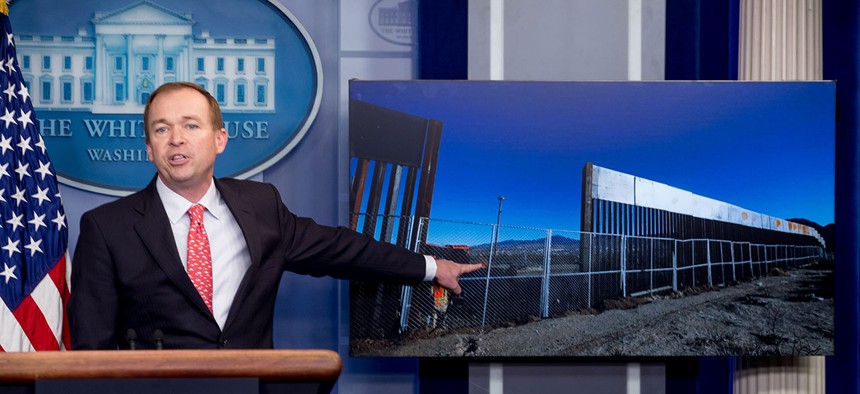The Trump Administration Sketches a Border-Fence Plan
Mick Mulvaney, the president’s budget director, told reporters Tuesday that 20-foot-tall steel fencing will replace existing cyclone fencing along the southern border.
Mick Mulvaney, the president’s budget director, said on Tuesday that the administration will replace segments of chain-link fencing with a 20-foot-tall steel fence along the southern border, despite Congress refusal to fund the president’s border wall in its spending bill.
Trump, for his part, has claimed that the administration is “beginning to build the wall,” which was a central plank of his presidential campaign, saying that “we're putting up a lot of new wall in certain areas.” Mulvaney elaborated Tuesday that there is funding to “replace cyclone fencing with 20-foot high steel wall.” He declined repeated questions from White House reporters about where along the border the fencing would go, or how many miles it would cover.
He was apparently referring to a provision in the spending bill unveiled by Congress earlier this week, which falls well short of the president’s repeated pledges. The bill allocates a little more than $341 million “to replace approximately 40 miles of existing primary pedestrian and vehicle border fencing along the southwest border using previously deployed and operationally effective designs, such as currently deployed steel bollard designs, that prioritize agent safety; and to add gates to existing barriers.” According to a 2009 report by the Government Accountability Office, existing vehicle and pedestrian fencing along the border averaged somewhere between $1 and $3.9 million to erect. The budget allocation implies that replacing that fencing with a steel-bollard design would cost $8.5 million per mile.
In 2006, President George W. Bush authorized the construction of a 700-mile wall of double layer fencing under the Secure Fence Act. Still, to seal off the border entirely, the wall would have to extend roughly 2,000 miles. And that’s a costly endeavor. According to estimates by the Department of Homeland Security, the wall’s price tag could be as much as $21.6 billion.
So far, the administration has only secured funds to improve existing fencing. When pressed on whether that was the most effective way to spend funds, Mulvaney said, “There are certain places where technology will also help.” He also noted that constructing a wall along the entire southern border “is a several year process.”
Building a wall along the southern border is a difficult task, and that may be especially true for the administration as it tries to close off the border in new areas. Mulvaney suggested that the administration will also prepare for land acquisition. During the Bush years, the administration focused on areas where most of the land belonged to the federal government, but along the Texas-Mexico border, much of the land is private property, raising the issue of eminent domain. Republicans have expressed concerns over the use of eminent domain, which some argue is an example of big government overreach, setting up a whole separate challenge for the White House.
Of course, Trump’s immigration crackdown includes more than a border wall. Also included in the government’s spending bill is funds for Customs and Border Patrol Protection and Immigration and Customs Enforcement. But at the very least, it’s a departure from Trump’s campaign pledges to have Mexico pay for the wall and signals the administration’s unrelenting stance on the construction of a physical barrier on the southern border.
NEXT STORY: OMB’s Biggest Challenge




